Environmental Management for Sustainable Development: A Comparison
VerifiedAdded on 2022/10/15
|8
|1772
|255
Report
AI Summary
This report provides a comparative analysis of environmental management practices in Australia and Sri Lanka. It begins by defining environmental management and its importance in addressing ecological and climate-related issues. The report then delves into the state of environmental management in both countries, highlighting the governmental bodies and legislative frameworks in place, such as the Environmental Protection and Biodiversity Conservation Act in Australia and the Central Environmental Authority in Sri Lanka. The report further examines the trends in resource management and policy development in both countries, focusing on the issue of water pollution. It analyzes the causes of water pollution, such as urbanization and household waste disposal in Australia, and the challenges faced by Sri Lanka due to its geographical conditions and rural populations. The report also explores the government's efforts to implement awareness strategies and water pollution management plans, while also highlighting the challenges such as literacy level differences and the lack of a surface or ground water quality assessment repository. The report concludes by emphasizing the need for effective water pollution management strategies and the importance of sustainable development practices in both countries.
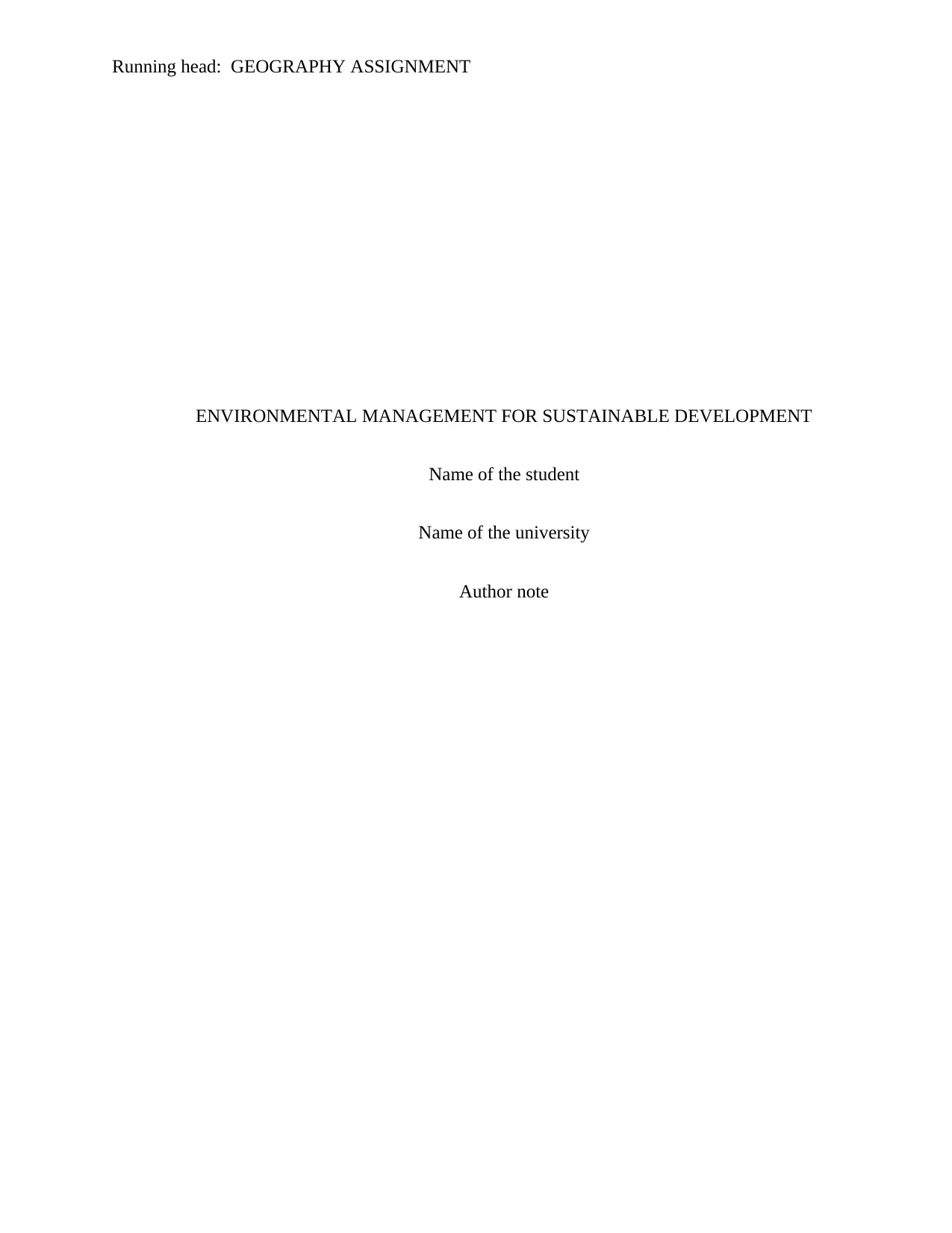
Running head: GEOGRAPHY ASSIGNMENT
ENVIRONMENTAL MANAGEMENT FOR SUSTAINABLE DEVELOPMENT
Name of the student
Name of the university
Author note
ENVIRONMENTAL MANAGEMENT FOR SUSTAINABLE DEVELOPMENT
Name of the student
Name of the university
Author note
Paraphrase This Document
Need a fresh take? Get an instant paraphrase of this document with our AI Paraphraser
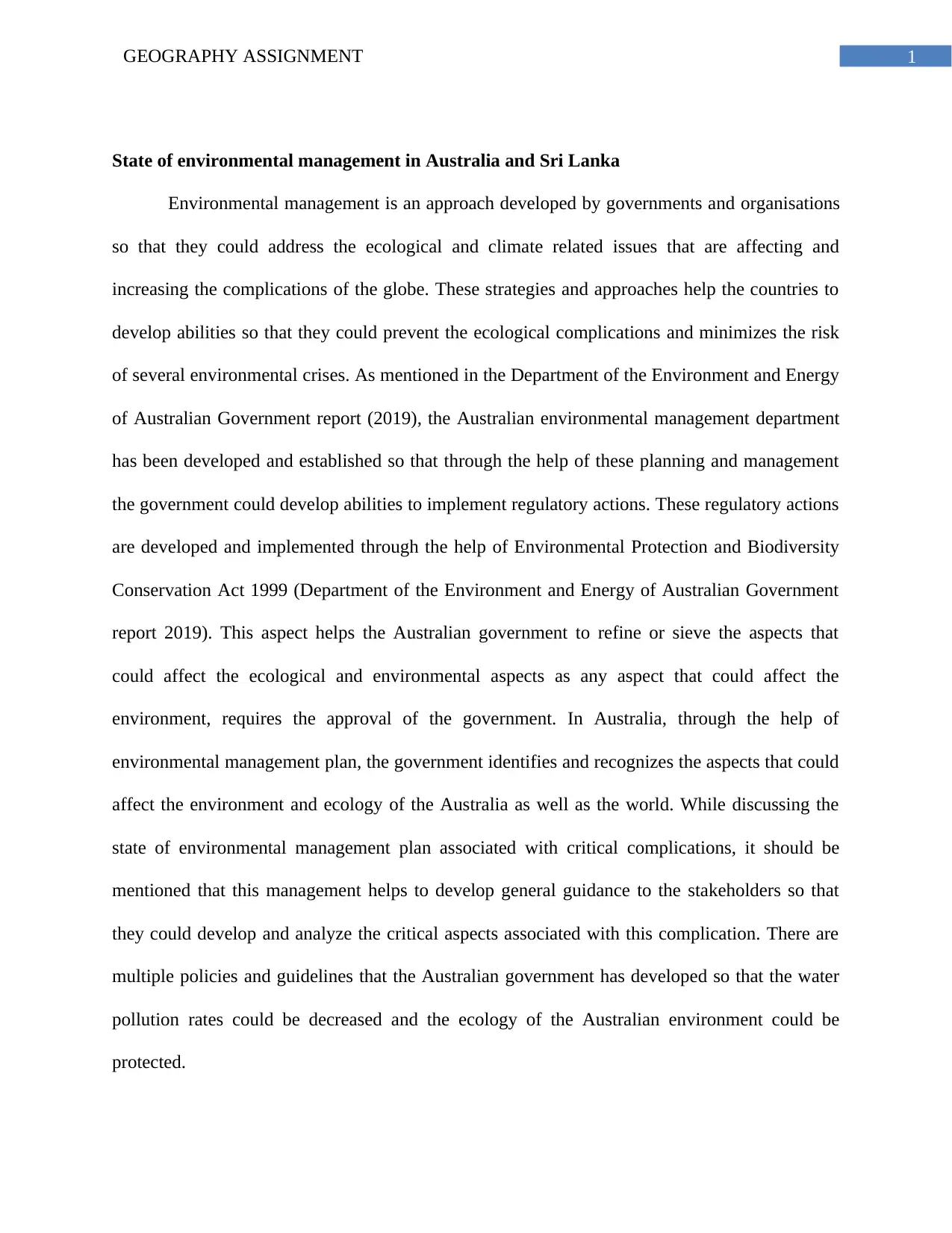
1GEOGRAPHY ASSIGNMENT
State of environmental management in Australia and Sri Lanka
Environmental management is an approach developed by governments and organisations
so that they could address the ecological and climate related issues that are affecting and
increasing the complications of the globe. These strategies and approaches help the countries to
develop abilities so that they could prevent the ecological complications and minimizes the risk
of several environmental crises. As mentioned in the Department of the Environment and Energy
of Australian Government report (2019), the Australian environmental management department
has been developed and established so that through the help of these planning and management
the government could develop abilities to implement regulatory actions. These regulatory actions
are developed and implemented through the help of Environmental Protection and Biodiversity
Conservation Act 1999 (Department of the Environment and Energy of Australian Government
report 2019). This aspect helps the Australian government to refine or sieve the aspects that
could affect the ecological and environmental aspects as any aspect that could affect the
environment, requires the approval of the government. In Australia, through the help of
environmental management plan, the government identifies and recognizes the aspects that could
affect the environment and ecology of the Australia as well as the world. While discussing the
state of environmental management plan associated with critical complications, it should be
mentioned that this management helps to develop general guidance to the stakeholders so that
they could develop and analyze the critical aspects associated with this complication. There are
multiple policies and guidelines that the Australian government has developed so that the water
pollution rates could be decreased and the ecology of the Australian environment could be
protected.
State of environmental management in Australia and Sri Lanka
Environmental management is an approach developed by governments and organisations
so that they could address the ecological and climate related issues that are affecting and
increasing the complications of the globe. These strategies and approaches help the countries to
develop abilities so that they could prevent the ecological complications and minimizes the risk
of several environmental crises. As mentioned in the Department of the Environment and Energy
of Australian Government report (2019), the Australian environmental management department
has been developed and established so that through the help of these planning and management
the government could develop abilities to implement regulatory actions. These regulatory actions
are developed and implemented through the help of Environmental Protection and Biodiversity
Conservation Act 1999 (Department of the Environment and Energy of Australian Government
report 2019). This aspect helps the Australian government to refine or sieve the aspects that
could affect the ecological and environmental aspects as any aspect that could affect the
environment, requires the approval of the government. In Australia, through the help of
environmental management plan, the government identifies and recognizes the aspects that could
affect the environment and ecology of the Australia as well as the world. While discussing the
state of environmental management plan associated with critical complications, it should be
mentioned that this management helps to develop general guidance to the stakeholders so that
they could develop and analyze the critical aspects associated with this complication. There are
multiple policies and guidelines that the Australian government has developed so that the water
pollution rates could be decreased and the ecology of the Australian environment could be
protected.
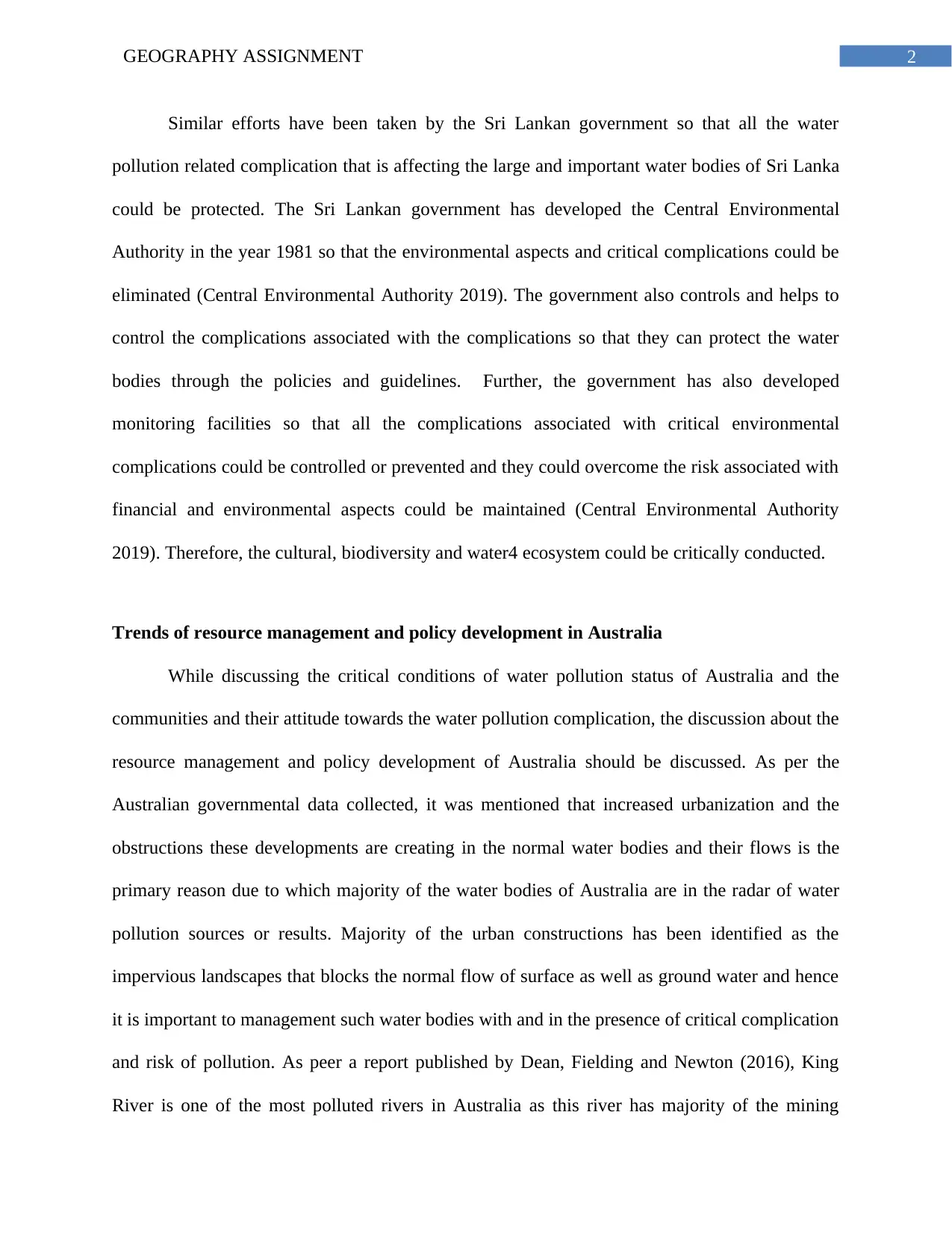
2GEOGRAPHY ASSIGNMENT
Similar efforts have been taken by the Sri Lankan government so that all the water
pollution related complication that is affecting the large and important water bodies of Sri Lanka
could be protected. The Sri Lankan government has developed the Central Environmental
Authority in the year 1981 so that the environmental aspects and critical complications could be
eliminated (Central Environmental Authority 2019). The government also controls and helps to
control the complications associated with the complications so that they can protect the water
bodies through the policies and guidelines. Further, the government has also developed
monitoring facilities so that all the complications associated with critical environmental
complications could be controlled or prevented and they could overcome the risk associated with
financial and environmental aspects could be maintained (Central Environmental Authority
2019). Therefore, the cultural, biodiversity and water4 ecosystem could be critically conducted.
Trends of resource management and policy development in Australia
While discussing the critical conditions of water pollution status of Australia and the
communities and their attitude towards the water pollution complication, the discussion about the
resource management and policy development of Australia should be discussed. As per the
Australian governmental data collected, it was mentioned that increased urbanization and the
obstructions these developments are creating in the normal water bodies and their flows is the
primary reason due to which majority of the water bodies of Australia are in the radar of water
pollution sources or results. Majority of the urban constructions has been identified as the
impervious landscapes that blocks the normal flow of surface as well as ground water and hence
it is important to management such water bodies with and in the presence of critical complication
and risk of pollution. As peer a report published by Dean, Fielding and Newton (2016), King
River is one of the most polluted rivers in Australia as this river has majority of the mining
Similar efforts have been taken by the Sri Lankan government so that all the water
pollution related complication that is affecting the large and important water bodies of Sri Lanka
could be protected. The Sri Lankan government has developed the Central Environmental
Authority in the year 1981 so that the environmental aspects and critical complications could be
eliminated (Central Environmental Authority 2019). The government also controls and helps to
control the complications associated with the complications so that they can protect the water
bodies through the policies and guidelines. Further, the government has also developed
monitoring facilities so that all the complications associated with critical environmental
complications could be controlled or prevented and they could overcome the risk associated with
financial and environmental aspects could be maintained (Central Environmental Authority
2019). Therefore, the cultural, biodiversity and water4 ecosystem could be critically conducted.
Trends of resource management and policy development in Australia
While discussing the critical conditions of water pollution status of Australia and the
communities and their attitude towards the water pollution complication, the discussion about the
resource management and policy development of Australia should be discussed. As per the
Australian governmental data collected, it was mentioned that increased urbanization and the
obstructions these developments are creating in the normal water bodies and their flows is the
primary reason due to which majority of the water bodies of Australia are in the radar of water
pollution sources or results. Majority of the urban constructions has been identified as the
impervious landscapes that blocks the normal flow of surface as well as ground water and hence
it is important to management such water bodies with and in the presence of critical complication
and risk of pollution. As peer a report published by Dean, Fielding and Newton (2016), King
River is one of the most polluted rivers in Australia as this river has majority of the mining
⊘ This is a preview!⊘
Do you want full access?
Subscribe today to unlock all pages.

Trusted by 1+ million students worldwide
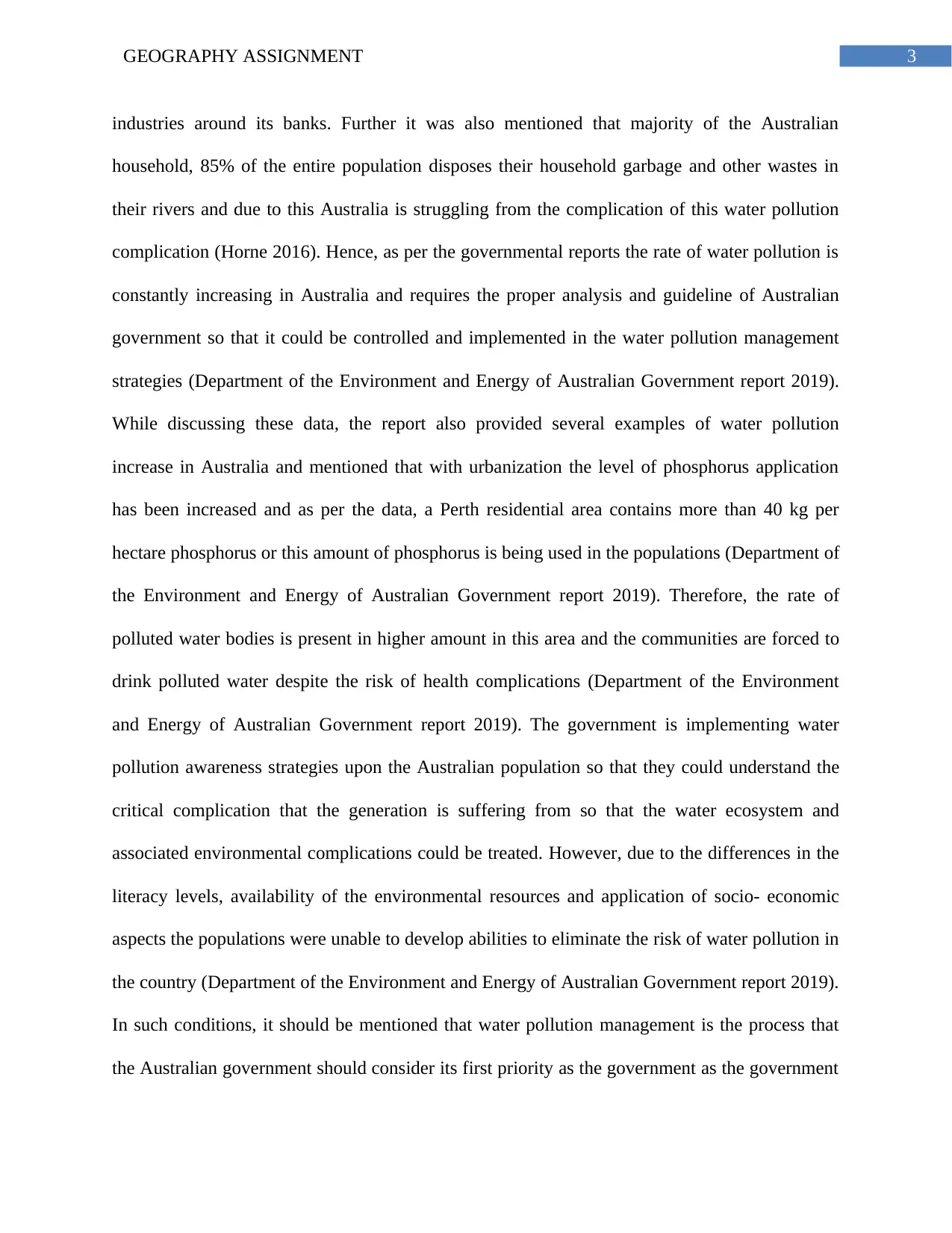
3GEOGRAPHY ASSIGNMENT
industries around its banks. Further it was also mentioned that majority of the Australian
household, 85% of the entire population disposes their household garbage and other wastes in
their rivers and due to this Australia is struggling from the complication of this water pollution
complication (Horne 2016). Hence, as per the governmental reports the rate of water pollution is
constantly increasing in Australia and requires the proper analysis and guideline of Australian
government so that it could be controlled and implemented in the water pollution management
strategies (Department of the Environment and Energy of Australian Government report 2019).
While discussing these data, the report also provided several examples of water pollution
increase in Australia and mentioned that with urbanization the level of phosphorus application
has been increased and as per the data, a Perth residential area contains more than 40 kg per
hectare phosphorus or this amount of phosphorus is being used in the populations (Department of
the Environment and Energy of Australian Government report 2019). Therefore, the rate of
polluted water bodies is present in higher amount in this area and the communities are forced to
drink polluted water despite the risk of health complications (Department of the Environment
and Energy of Australian Government report 2019). The government is implementing water
pollution awareness strategies upon the Australian population so that they could understand the
critical complication that the generation is suffering from so that the water ecosystem and
associated environmental complications could be treated. However, due to the differences in the
literacy levels, availability of the environmental resources and application of socio- economic
aspects the populations were unable to develop abilities to eliminate the risk of water pollution in
the country (Department of the Environment and Energy of Australian Government report 2019).
In such conditions, it should be mentioned that water pollution management is the process that
the Australian government should consider its first priority as the government as the government
industries around its banks. Further it was also mentioned that majority of the Australian
household, 85% of the entire population disposes their household garbage and other wastes in
their rivers and due to this Australia is struggling from the complication of this water pollution
complication (Horne 2016). Hence, as per the governmental reports the rate of water pollution is
constantly increasing in Australia and requires the proper analysis and guideline of Australian
government so that it could be controlled and implemented in the water pollution management
strategies (Department of the Environment and Energy of Australian Government report 2019).
While discussing these data, the report also provided several examples of water pollution
increase in Australia and mentioned that with urbanization the level of phosphorus application
has been increased and as per the data, a Perth residential area contains more than 40 kg per
hectare phosphorus or this amount of phosphorus is being used in the populations (Department of
the Environment and Energy of Australian Government report 2019). Therefore, the rate of
polluted water bodies is present in higher amount in this area and the communities are forced to
drink polluted water despite the risk of health complications (Department of the Environment
and Energy of Australian Government report 2019). The government is implementing water
pollution awareness strategies upon the Australian population so that they could understand the
critical complication that the generation is suffering from so that the water ecosystem and
associated environmental complications could be treated. However, due to the differences in the
literacy levels, availability of the environmental resources and application of socio- economic
aspects the populations were unable to develop abilities to eliminate the risk of water pollution in
the country (Department of the Environment and Energy of Australian Government report 2019).
In such conditions, it should be mentioned that water pollution management is the process that
the Australian government should consider its first priority as the government as the government
Paraphrase This Document
Need a fresh take? Get an instant paraphrase of this document with our AI Paraphraser
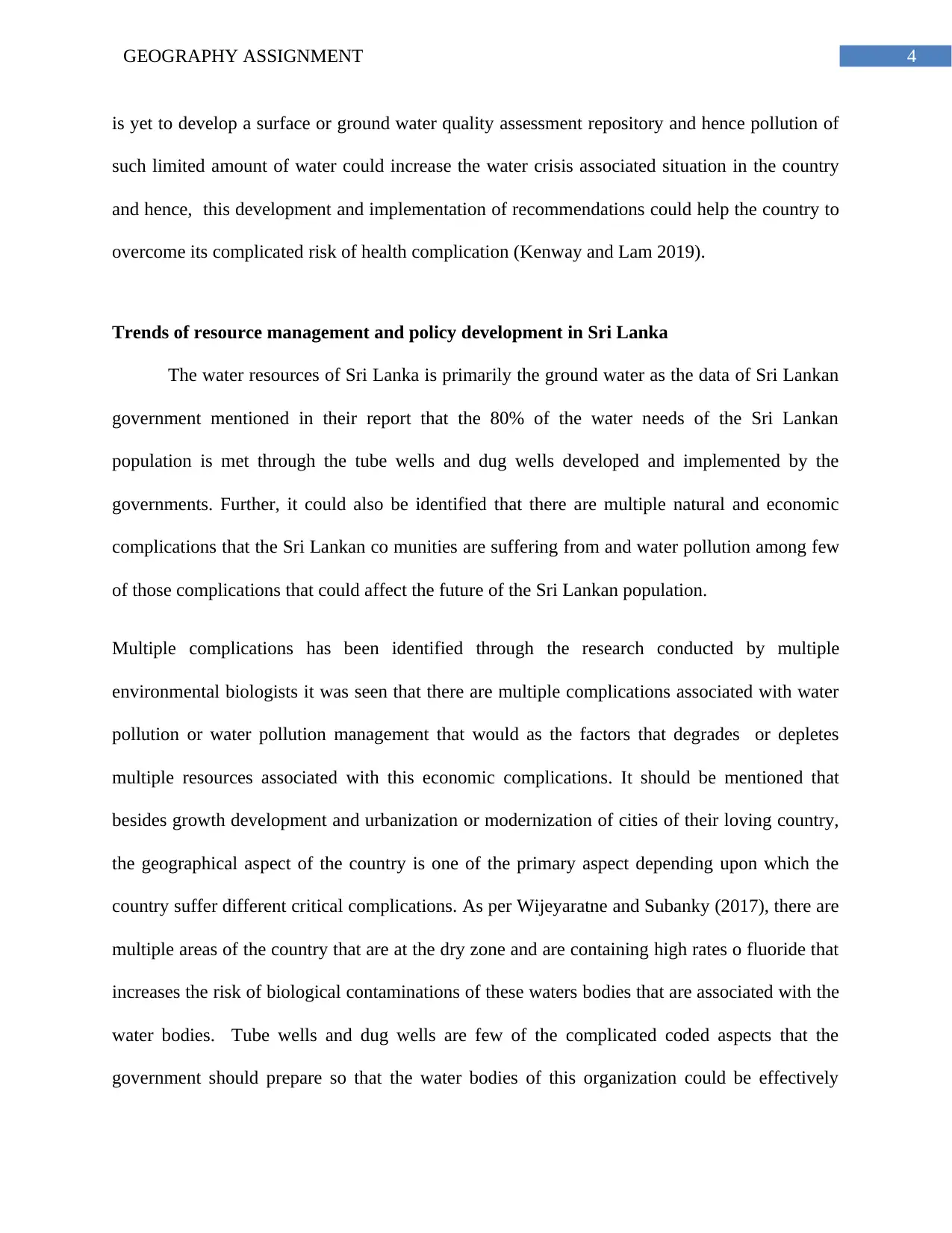
4GEOGRAPHY ASSIGNMENT
is yet to develop a surface or ground water quality assessment repository and hence pollution of
such limited amount of water could increase the water crisis associated situation in the country
and hence, this development and implementation of recommendations could help the country to
overcome its complicated risk of health complication (Kenway and Lam 2019).
Trends of resource management and policy development in Sri Lanka
The water resources of Sri Lanka is primarily the ground water as the data of Sri Lankan
government mentioned in their report that the 80% of the water needs of the Sri Lankan
population is met through the tube wells and dug wells developed and implemented by the
governments. Further, it could also be identified that there are multiple natural and economic
complications that the Sri Lankan co munities are suffering from and water pollution among few
of those complications that could affect the future of the Sri Lankan population.
Multiple complications has been identified through the research conducted by multiple
environmental biologists it was seen that there are multiple complications associated with water
pollution or water pollution management that would as the factors that degrades or depletes
multiple resources associated with this economic complications. It should be mentioned that
besides growth development and urbanization or modernization of cities of their loving country,
the geographical aspect of the country is one of the primary aspect depending upon which the
country suffer different critical complications. As per Wijeyaratne and Subanky (2017), there are
multiple areas of the country that are at the dry zone and are containing high rates o fluoride that
increases the risk of biological contaminations of these waters bodies that are associated with the
water bodies. Tube wells and dug wells are few of the complicated coded aspects that the
government should prepare so that the water bodies of this organization could be effectively
is yet to develop a surface or ground water quality assessment repository and hence pollution of
such limited amount of water could increase the water crisis associated situation in the country
and hence, this development and implementation of recommendations could help the country to
overcome its complicated risk of health complication (Kenway and Lam 2019).
Trends of resource management and policy development in Sri Lanka
The water resources of Sri Lanka is primarily the ground water as the data of Sri Lankan
government mentioned in their report that the 80% of the water needs of the Sri Lankan
population is met through the tube wells and dug wells developed and implemented by the
governments. Further, it could also be identified that there are multiple natural and economic
complications that the Sri Lankan co munities are suffering from and water pollution among few
of those complications that could affect the future of the Sri Lankan population.
Multiple complications has been identified through the research conducted by multiple
environmental biologists it was seen that there are multiple complications associated with water
pollution or water pollution management that would as the factors that degrades or depletes
multiple resources associated with this economic complications. It should be mentioned that
besides growth development and urbanization or modernization of cities of their loving country,
the geographical aspect of the country is one of the primary aspect depending upon which the
country suffer different critical complications. As per Wijeyaratne and Subanky (2017), there are
multiple areas of the country that are at the dry zone and are containing high rates o fluoride that
increases the risk of biological contaminations of these waters bodies that are associated with the
water bodies. Tube wells and dug wells are few of the complicated coded aspects that the
government should prepare so that the water bodies of this organization could be effectively
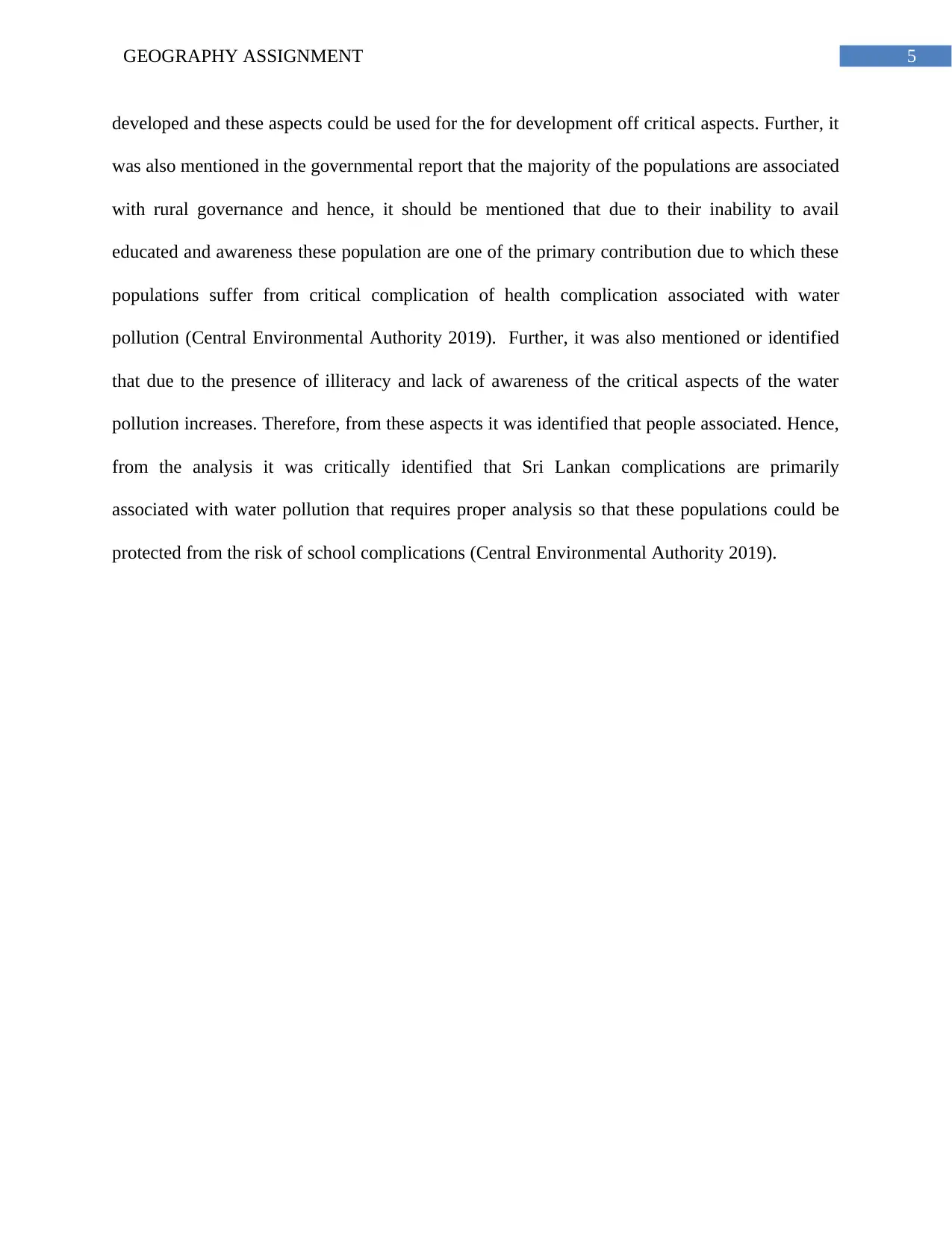
5GEOGRAPHY ASSIGNMENT
developed and these aspects could be used for the for development off critical aspects. Further, it
was also mentioned in the governmental report that the majority of the populations are associated
with rural governance and hence, it should be mentioned that due to their inability to avail
educated and awareness these population are one of the primary contribution due to which these
populations suffer from critical complication of health complication associated with water
pollution (Central Environmental Authority 2019). Further, it was also mentioned or identified
that due to the presence of illiteracy and lack of awareness of the critical aspects of the water
pollution increases. Therefore, from these aspects it was identified that people associated. Hence,
from the analysis it was critically identified that Sri Lankan complications are primarily
associated with water pollution that requires proper analysis so that these populations could be
protected from the risk of school complications (Central Environmental Authority 2019).
developed and these aspects could be used for the for development off critical aspects. Further, it
was also mentioned in the governmental report that the majority of the populations are associated
with rural governance and hence, it should be mentioned that due to their inability to avail
educated and awareness these population are one of the primary contribution due to which these
populations suffer from critical complication of health complication associated with water
pollution (Central Environmental Authority 2019). Further, it was also mentioned or identified
that due to the presence of illiteracy and lack of awareness of the critical aspects of the water
pollution increases. Therefore, from these aspects it was identified that people associated. Hence,
from the analysis it was critically identified that Sri Lankan complications are primarily
associated with water pollution that requires proper analysis so that these populations could be
protected from the risk of school complications (Central Environmental Authority 2019).
⊘ This is a preview!⊘
Do you want full access?
Subscribe today to unlock all pages.

Trusted by 1+ million students worldwide
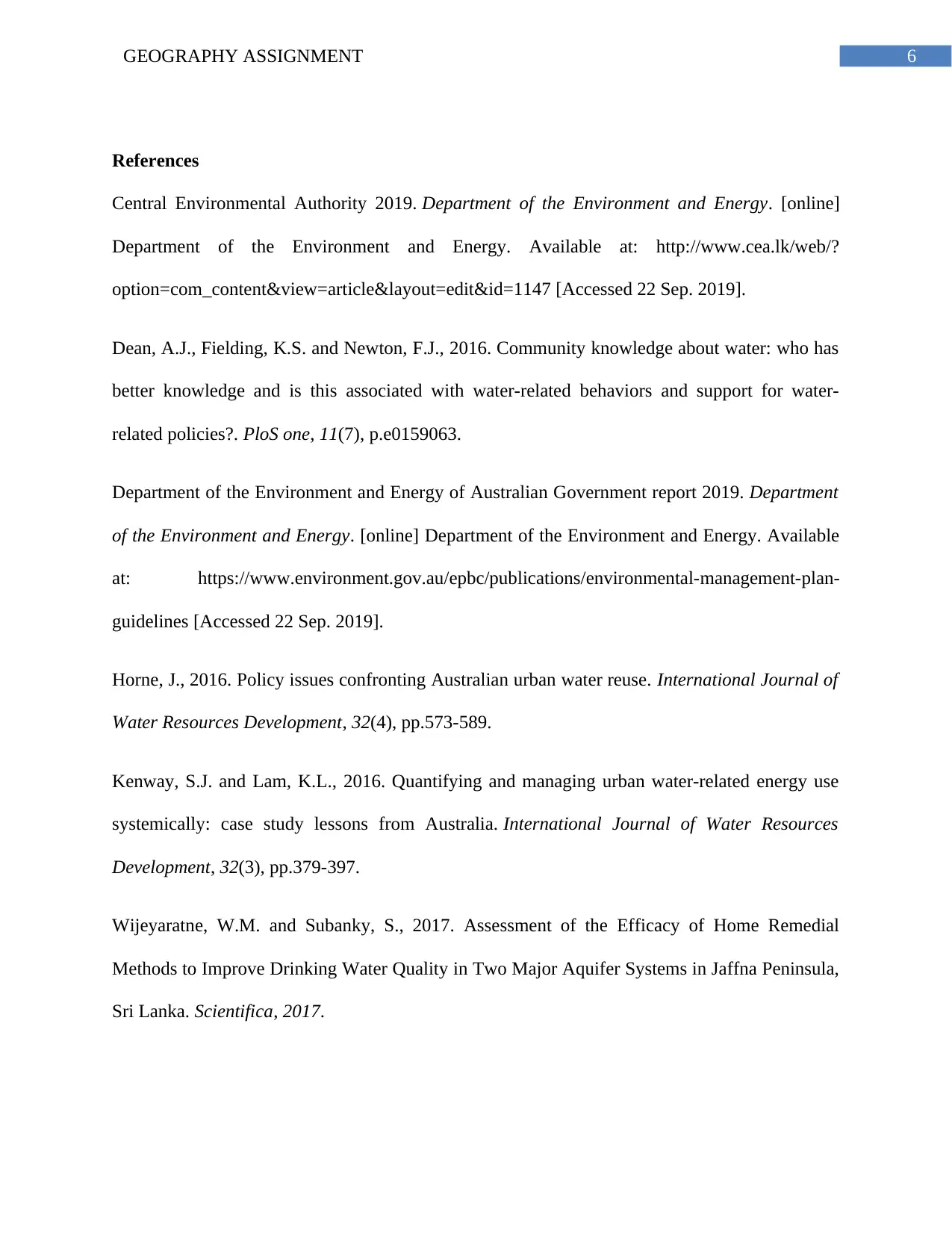
6GEOGRAPHY ASSIGNMENT
References
Central Environmental Authority 2019. Department of the Environment and Energy. [online]
Department of the Environment and Energy. Available at: http://www.cea.lk/web/?
option=com_content&view=article&layout=edit&id=1147 [Accessed 22 Sep. 2019].
Dean, A.J., Fielding, K.S. and Newton, F.J., 2016. Community knowledge about water: who has
better knowledge and is this associated with water-related behaviors and support for water-
related policies?. PloS one, 11(7), p.e0159063.
Department of the Environment and Energy of Australian Government report 2019. Department
of the Environment and Energy. [online] Department of the Environment and Energy. Available
at: https://www.environment.gov.au/epbc/publications/environmental-management-plan-
guidelines [Accessed 22 Sep. 2019].
Horne, J., 2016. Policy issues confronting Australian urban water reuse. International Journal of
Water Resources Development, 32(4), pp.573-589.
Kenway, S.J. and Lam, K.L., 2016. Quantifying and managing urban water-related energy use
systemically: case study lessons from Australia. International Journal of Water Resources
Development, 32(3), pp.379-397.
Wijeyaratne, W.M. and Subanky, S., 2017. Assessment of the Efficacy of Home Remedial
Methods to Improve Drinking Water Quality in Two Major Aquifer Systems in Jaffna Peninsula,
Sri Lanka. Scientifica, 2017.
References
Central Environmental Authority 2019. Department of the Environment and Energy. [online]
Department of the Environment and Energy. Available at: http://www.cea.lk/web/?
option=com_content&view=article&layout=edit&id=1147 [Accessed 22 Sep. 2019].
Dean, A.J., Fielding, K.S. and Newton, F.J., 2016. Community knowledge about water: who has
better knowledge and is this associated with water-related behaviors and support for water-
related policies?. PloS one, 11(7), p.e0159063.
Department of the Environment and Energy of Australian Government report 2019. Department
of the Environment and Energy. [online] Department of the Environment and Energy. Available
at: https://www.environment.gov.au/epbc/publications/environmental-management-plan-
guidelines [Accessed 22 Sep. 2019].
Horne, J., 2016. Policy issues confronting Australian urban water reuse. International Journal of
Water Resources Development, 32(4), pp.573-589.
Kenway, S.J. and Lam, K.L., 2016. Quantifying and managing urban water-related energy use
systemically: case study lessons from Australia. International Journal of Water Resources
Development, 32(3), pp.379-397.
Wijeyaratne, W.M. and Subanky, S., 2017. Assessment of the Efficacy of Home Remedial
Methods to Improve Drinking Water Quality in Two Major Aquifer Systems in Jaffna Peninsula,
Sri Lanka. Scientifica, 2017.
Paraphrase This Document
Need a fresh take? Get an instant paraphrase of this document with our AI Paraphraser
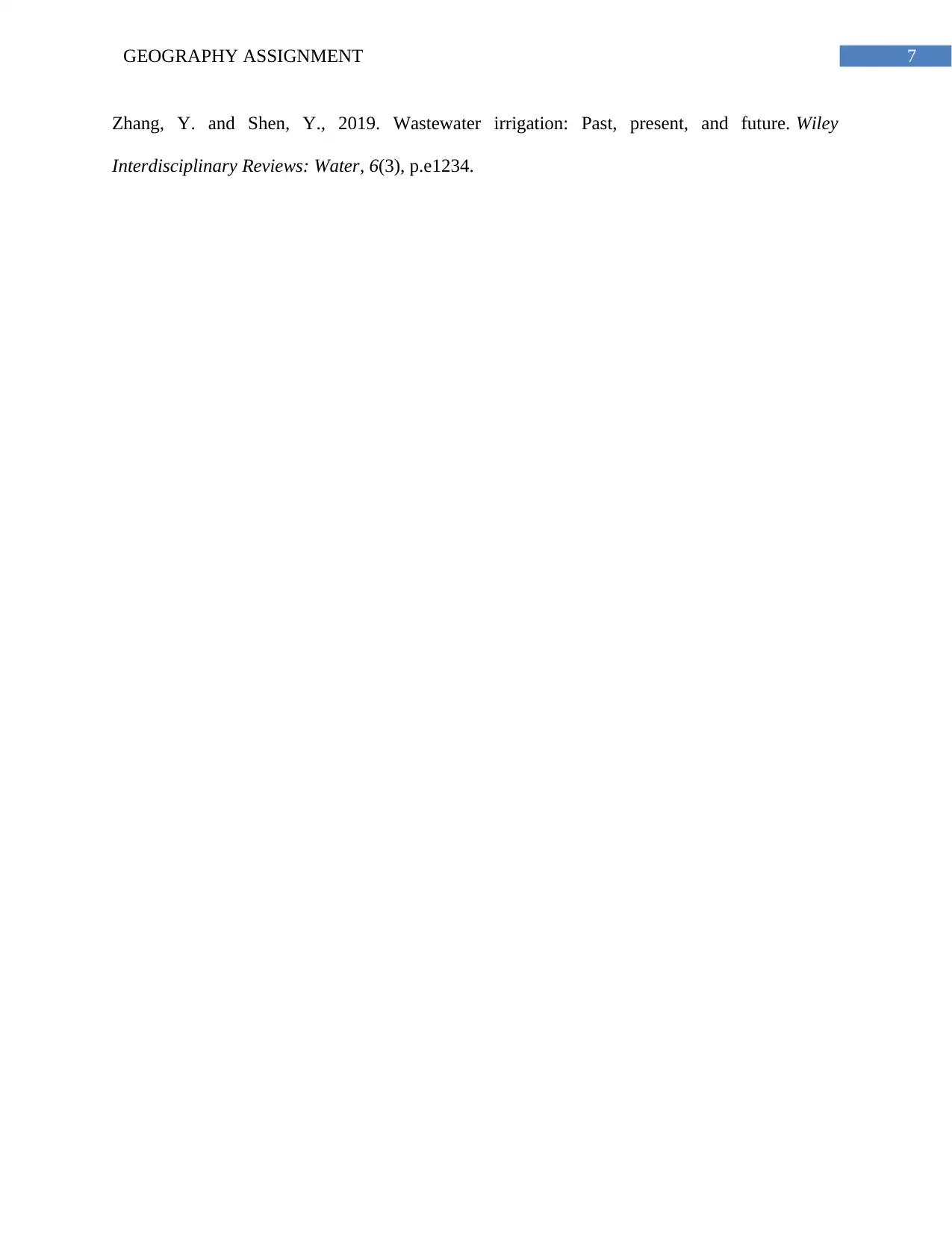
7GEOGRAPHY ASSIGNMENT
Zhang, Y. and Shen, Y., 2019. Wastewater irrigation: Past, present, and future. Wiley
Interdisciplinary Reviews: Water, 6(3), p.e1234.
Zhang, Y. and Shen, Y., 2019. Wastewater irrigation: Past, present, and future. Wiley
Interdisciplinary Reviews: Water, 6(3), p.e1234.
1 out of 8
Related Documents
Your All-in-One AI-Powered Toolkit for Academic Success.
+13062052269
info@desklib.com
Available 24*7 on WhatsApp / Email
![[object Object]](/_next/static/media/star-bottom.7253800d.svg)
Unlock your academic potential
Copyright © 2020–2025 A2Z Services. All Rights Reserved. Developed and managed by ZUCOL.





